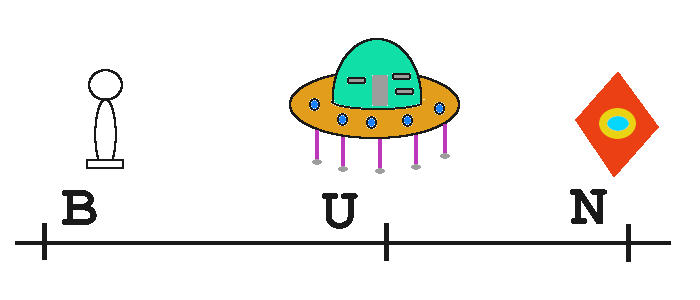STR with "Snow Globe Theory"

UFO (U) flies past me (B) at high speed v. At the same moment, I send a beam of light in the direction of flight.
Since the UFO is moving close to the speed of light c, I find it with sensors not far behind the light front (N).
Unfortunately, I can't see this despite the dusty cloud, because light takes a certain amount of time.
The light could just as easily have been emitted by the UFO, with the same light front; otherwise,
there would be superluminal speed. The short distance N-U makes it seem as if light were moving more slowly in system U.*
However, with the "snow globe theory" and Theorem S3, the speed of light there is the same as everywhere else in the world.
After time t, the distance N-U is measured as (c-v)·t.
Can I use this to determine the factor of scale changes (F)?
This distance from U to N has a length c·t' in system U, where t' is time there.
The inverse of the observed length contraction and thus the time dilation is:
The time t' in system U corresponds to the time it takes for light to travel from U to N. For me (B), however, t is the time it takes for light to travel from B to N, my time from the beginning. The corresponding path in U is v·t'+c·t'. Velocity is length divided by time, so time is length divided by velocity. The time tU from B to N for light is t'·(v+c)/c . The factor for proper time (1/F) is calculated as t'·(v/c+1)/t. Solving for t:
Substituting this into the above equation and using the binomial formula, this gives F²=1/(1-v²/c²). Thus:
The factor of scale changes or time dilation is therefore the famous Lorentz factor.
As is well known, with this factor the Lorentz transformation results from the Galilean transformation and the symmetry of the initial systems.
Length shortening in STR
*This is a fallacy. The UFO could just as easily fly in the other direction.
In that case, the speed would be negative, and the same formulas would apply.
t easily explains the Minkowski cone.
The light fronts to the right and left of the UFO appear to be at different distances.
Local, relative to a center line, they are the same distance away.
Light appears to move very slowly in one direction.
In the other direction, it appears to travel faster than the speed of light.
Don't trust optics;
trust proper time and S3.
Ludwig Resch